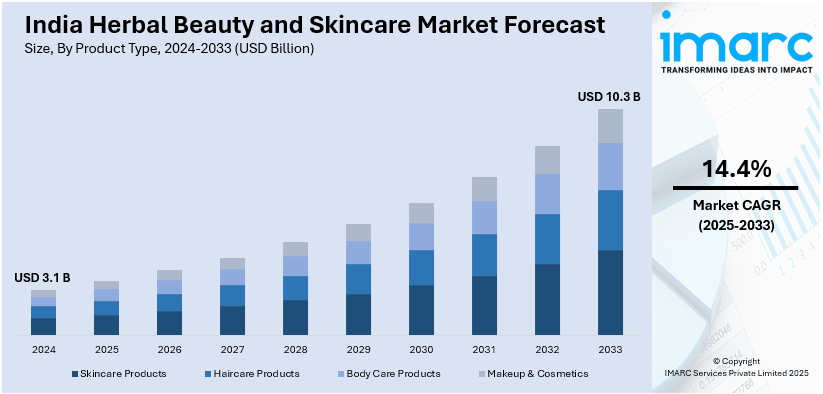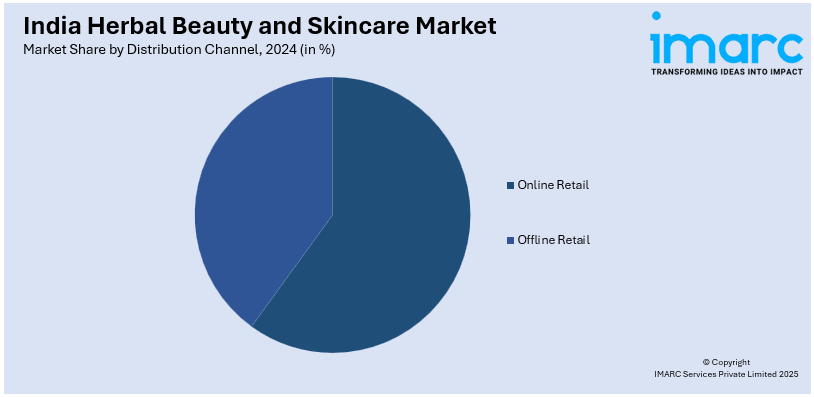
India Herbal Beauty and Skincare Market Size, Share, Trends and Forecast by Product Type, Ingredient Type, Distribution Channel, End User and Region, 2025-2033
India Herbal Beauty and Skincare Market Overview:
The India herbal beauty and skincare market size reached USD 3.1 Billion in 2024. Looking forward, IMARC Group expects the market to reach USD 10.3 Billion by 2033, exhibiting a growth rate (CAGR) of 14.4% during 2025-2033. The market is boosted by rising awareness about natural ingredients among consumers, growing demand for organic products, and skin care concerns. The rising trend toward chemical-free, nature-friendly solutions and growing influence of social media and traditional practices are also accelerating the India herbal beauty and skincare market share.
|
Report Attribute
|
Key Statistics
|
|---|---|
|
Base Year
|
2024 |
|
Forecast Years
|
2025-2033
|
|
Historical Years
|
2019-2024
|
| Market Size in 2024 | USD 3.1 Billion |
| Market Forecast in 2033 | USD 10.3 Billion |
| Market Growth Rate 2025-2033 | 14.4% |
India Herbal Beauty and Skincare Market Trends:
Rising Demand for Natural and Organic Products
The increasing demand for organic and natural beauty and skincare products is a major trend influencing the India herbal beauty and skincare market outlook. People are becoming more aware of the ill effects of chemicals used in traditional skincare products, which has resulted in a move towards herbal products that offer safer, more natural solutions. Herbal products, which incorporate ingredients such as aloe vera, turmeric, neem, and sandalwood, are being sought after for their nourishing and non-toxic nature. This trend is most prominent with younger consumers and sensitive skin types, who look for paraben-, sulfate-, and fragrance-free products. The greater influence of social media, where influencers and skincare specialists promote the natural beauty routine, is speeding the trend toward herbal solutions. Additionally, the organic certifications and eco-friendly packaging push is propelling this trend forward as consumers desire a product that shares the values of living healthy and is sustainable too.

To get more information on this market, Request Sample
Infusion of AI Tools with Natural Product Formulations
The fusion of Artificial Intelligence (AI) technologies with herbal product formulations is becoming a leading trend fueling the India herbal beauty and skincare market growth. AI technology is utilized for creating customized skincare products by examining consumer skin types, skin concerns, and skin preferences. AI-based algorithms can suggest the right natural ingredients that are most effective for a particular individual's skin, maximizing the effectiveness of herbal products. Moreover, AI is assisting companies in enhancing the formulation process through the analysis of large data to determine combinations of herbal ingredients that can increase the effectiveness of products. The technology enables the creation of more effective, personalized products, which improve customer satisfaction. For example, AI software is able to anticipate skin reactions to certain herbal ingredients, making sure the formulation is safe and therapeutic. With personalization becoming increasingly popular, the coming together of AI and natural skincare solutions is likely to change the face of consumers when it comes to beauty and skincare routine. For example, Biotique, a beauty and wellness firm rooted in Ayurveda, is heavily investing in innovative technologies such as artificial intelligence (AI), augmented reality (AR), and personalized care to transform consumer experiences. At its essence, Biotique merges the age-old science of Ayurveda with modern biotechnology to develop superior, efficient products.
Growth of Ayurvedic Skincare Solutions
Ayurveda, the traditional system of medicine in India, is increasingly making its mark on the herbal beauty and skincare industry. Ayurvedic skincare products, rooted in the holistic philosophy of balancing body and mind, are becoming popular across the board for their capacity to treat skin issues in a natural, effective manner. The application of herbs, oils, and natural extracts such as neem, tulsi, and ashwagandha, which have been a part of traditional beauty treatments for centuries, is gaining popularity. Ayurvedic products are valued for their long-term effects, offering consumers solutions to everyday skincare problems like acne, pigmentation, and dryness. With increased awareness of the potential of Ayurveda in skincare, a number of top brands are integrating Ayurvedic principles into their product offerings, and new startups are concentrating on traditional recipes. The Ayurvedic trend is further supported by an increasing demand for holistic wellness since consumers want products that work on the skin while also encouraging overall well-being.
India Herbal Beauty and Skincare Market Segmentation:
IMARC Group provides an analysis of the key trends in each segment of the market, along with forecasts at the regional level for 2025-2033. Our report has categorized the market based on product type, ingredient type, distribution channel, and end user.
Product Type Insights:
- Skincare Products
- Face Creams and Moisturizers
- Face Wash and Cleansers
- Sunscreens and Sun Protection
- Anti-Aging and Wrinkle Care
- Face Masks and Scrubs
- Haircare Products
- Herbal Shampoos
- Conditioners and Hair Oils
- Hair Serums and Treatments
- Body Care Products
- Soaps and Body Wash
- Body Lotions and Creams
- Makeup & Cosmetics
- Herbal Lipsticks and Lip Balms
- Herbal Foundations and BB Creams
- Herbal Kajal and Eye Makeup
The report has provided a detailed breakup and analysis of the market based on the product type. this includes skincare products (face creams and moisturizers, face wash and cleansers, sunscreens and sun protection, anti-aging and wrinkle care, face masks and scrubs), haircare products (herbal shampoos, conditioners and hair oils, hair serums and treatments), body care products (soaps and body wash and body lotions and creams), and makeup & cosmetics (herbal lipsticks and lip balms, herbal foundations and bb creams, herbal kajal and eye makeup).
Ingredient Type Insights:
- Aloe Vera
- Neem
- Turmeric
- Tulsi (Holy Basil)
- Amla
- Others
The report has provided a detailed breakup and analysis of the market based on the ingredient type. This includes aloe vera, neem, turmeric, tulsi (holy basil), amla, and others.
Distribution Channel Insights:

- Online Retail
- Offline Retail
The report has provided a detailed breakup and analysis of the market based on the distribution channel. This includes online retail, and offline retail.
End User Insights:
- Men
- Women
- Unisex
The report has provided a detailed breakup and analysis of the market based on the end user. This includes men, women, and unisex.
Regional Insights:
- North India
- South India
- East India
- West India
The report has also provided a comprehensive analysis of all the major regional markets, which include North India, South India, East India, and West India.
Competitive Landscape:
The market research report has also provided a comprehensive analysis of the competitive landscape. Competitive analysis such as market structure, key player positioning, top winning strategies, competitive dashboard, and company evaluation quadrant has been covered in the report. Also, detailed profiles of all major companies have been provided.
India Herbal Beauty and Skincare Market News:
- In May 2024, Forest Essentials introduced its new natural makeup line known as the 'Soundarya' range. The Forest Essentials Soundarya Radiance Day Cream featuring 24K Gold and SPF25 is among the brand's best selections. This beloved product is a creamy face moisturizer that features a blend of valuable herbs and 24K gold, aiding in the restoration of skin's firmness.
- In June 2024, Lotus Herbals launched a USD 50 Million fund to support beauty care startups. As the second fund of its kind to debut in India, it will focus on investing in early-stage startups within the beauty sector. Established in 1993, Lotus Herbals is a company that creates natural cosmetics, combining the ancient science of Ayurveda, which dates back 5,000 years, with contemporary technology.
India Herbal Beauty and Skincare Market Report Coverage:
| Report Features | Details |
|---|---|
| Base Year of the Analysis | 2024 |
| Historical Period | 2019-2024 |
| Forecast Period | 2025-2033 |
| Units | Billion USD |
| Scope of the Report |
Exploration of Historical Trends and Market Outlook, Industry Catalysts and Challenges, Segment-Wise Historical and Future Market Assessment:
|
| Product Types Covered |
|
| Ingredient Types Covered | Aloe Vera, Neem, Turmeric, Tulsi (Holy Basil), Amla, Others |
| Distribution Channels Covered | Online Retail, Offline Retail |
| End Users Covered | Men, Women, Unisex |
| Regions Covered | North India, South India, East India, West India |
| Customization Scope | 10% Free Customization |
| Post-Sale Analyst Support | 10-12 Weeks |
| Delivery Format | PDF and Excel through Email (We can also provide the editable version of the report in PPT/Word format on special request) |
Key Questions Answered in This Report:
- How has the India herbal beauty and skincare market performed so far and how will it perform in the coming years?
- What is the breakup of the India herbal beauty and skincare market on the basis of product type?
- What is the breakup of the India herbal beauty and skincare market on the basis of ingredient type?
- What is the breakup of the India herbal beauty and skincare market on the basis of distribution channel?
- What is the breakup of the India herbal beauty and skincare market on the basis of end user?
- What is the breakup of the India herbal beauty and skincare market on the basis of region?
- What are the various stages in the value chain of the India herbal beauty and skincare market?
- What are the key driving factors and challenges in the India herbal beauty and skincare market?
- What is the structure of the India herbal beauty and skincare market and who are the key players?
- What is the degree of competition in the India herbal beauty and skincare market?
Key Benefits for Stakeholders:
- IMARC’s industry report offers a comprehensive quantitative analysis of various market segments, historical and current market trends, market forecasts, and dynamics of the India herbal beauty and skincare market from 2019-2033.
- The research report provides the latest information on the market drivers, challenges, and opportunities in the India herbal beauty and skincare market.
- Porter's five forces analysis assist stakeholders in assessing the impact of new entrants, competitive rivalry, supplier power, buyer power, and the threat of substitution. It helps stakeholders to analyze the level of competition within the India herbal beauty and skincare industry and its attractiveness.
- Competitive landscape allows stakeholders to understand their competitive environment and provides an insight into the current positions of key players in the market.
Need more help?
- Speak to our experienced analysts for insights on the current market scenarios.
- Include additional segments and countries to customize the report as per your requirement.
- Gain an unparalleled competitive advantage in your domain by understanding how to utilize the report and positively impacting your operations and revenue.
- For further assistance, please connect with our analysts.
 Request Customization
Request Customization
 Speak to an Analyst
Speak to an Analyst
 Request Brochure
Request Brochure
 Inquire Before Buying
Inquire Before Buying




.webp)




.webp)












